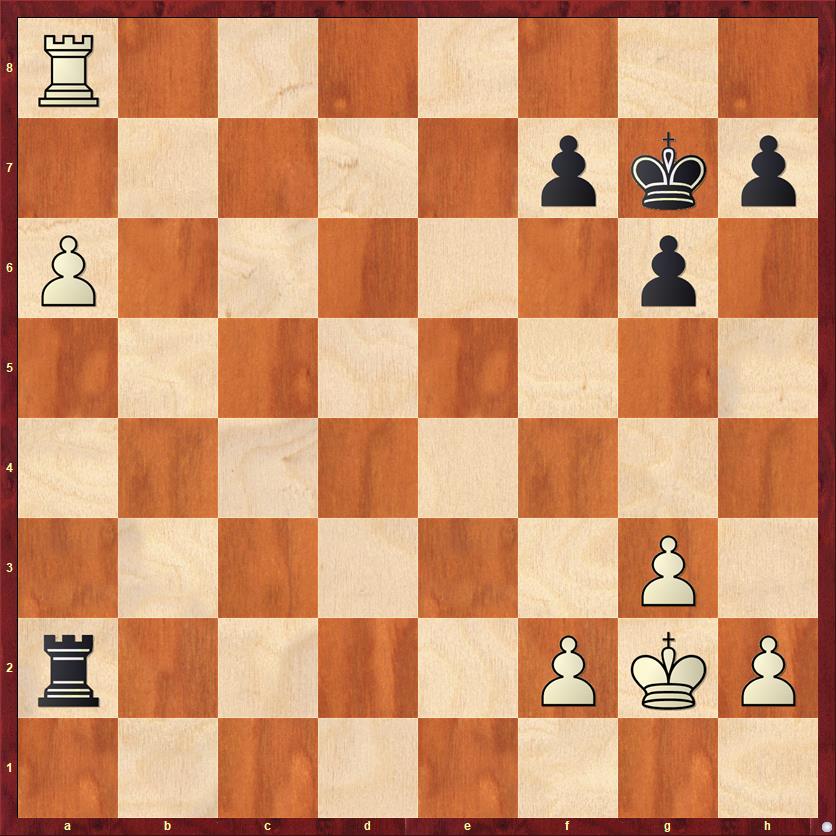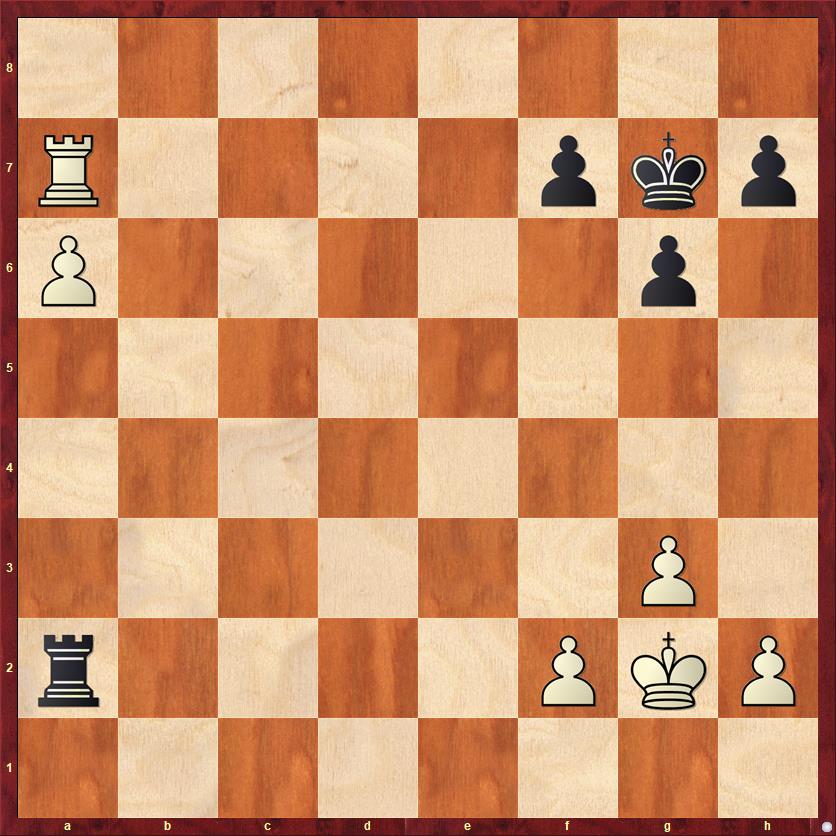I’m back! Actually, I never left, but this blog has been silent for seven weeks, so some of you may have been wondering where I went. My apologies: I was busy with other things (like a book proposal), but to be honest, I just didn’t have any topics that were worth writing about. I could continue to write about my disastrous tournament in Minnesota back in August, but I just didn’t think that this sort of self-flagellation will be beneficial to my readers. The only other games I’ve played recently are against the computer, and I think that those rarely make good blog posts. Computer chess is just too different from human chess, and my play in Minnesota already showed signs of too much training against the computer, and not enough training against humans.
But in the last couple weeks, I have been diving deep into the secrets of one of the most tricky and yet also most common endgames in chess: the rook and pawn endgame where one side has an outside passed pawn (typically an a-pawn). I’m planning a four-part series, which I’ll divide up as follows:
- Part 1: Introduction
- Part 2: The Fine Position
- Part 3: A Finer Position
- Part 4: An Ordinary Position
Let’s jump in! Here is what I call “the Fine position.”

FEN: R7/5pkp/P5p1/8/8/6P1/r4PKP/8 w – – 0 1
To be specific, this is position number 367 in Reuben Fine’s Basic Chess Endings, page 341. First, Fine notes the general principle that is known (on Wikipedia, at least) as the “Tarrasch Rule”: for both the attacker and defender, the best place for the rook is behind the passed pawn. Of course, only one side can succeed in putting his rook there, and Fine says: “The game is drawn if the defender’s Rook is behind the Pawn, but lost if it is in front of the Pawn.” Further, he explains:
“When the Black Rook is behind the Pawn, the White Rook in front of it, we get the typical draw in No. 367. The idea of the draw is this: In order to win, White will have to keep his Pawn on R6, and march his King to the Q-side. He will thus expose his K-side and have to lose at least one pawn. Once Black has captured a Pawn, he [that is, White — DM] will advance his King and will then win Black’s Rook for the QRP, but White will emerge with a R vs. P ending in which his King is too far away to be able to effect a win. If White gets frisky and sacrifices more than one Pawn, Black may even win.”
Sounds simple, right? That’s what I thought, too, until I started playing this endgame against the computer. All of a sudden it turned out that White has an inordinate number of tricks and that it is extremely hard for Black to set up the sort of drawing procedure that Fine writes about. If Black’s king advances too early or too late, he loses. Gradually, after several hours of analysis with the computer, I started to come to an amazing conclusion: the following position, almost identical to the Fine Position, is a win for White!

FEN: 8/R4pkp/P5p1/8/8/6P1/r4PKP/8 w – – 0 1
I’ll call this the Finer Position and cover it in part three of this series. Let me say right now that I am not 100 percent sure that White is winning, but I can tell you two things with certainty. First, from playing this endgame against the computer, I can tell you that White’s chances of winning are much greater than Fine admits. Second, after analyzing this endgame with the computer, I can tell you that I have yet to find a way for Black to force a draw from the Finer Position.
I do think that Fine’s evaluation of the Fine Position is correct — it is a draw with best play — but even that is not as routine as he thinks. Also, there’s a broader lesson: there is no such thing as a typical position in this endgame. Even moving the rook from a8 to a7 may change the outcome. The details of the pawn structure, the king positions, and how far advanced the a-pawn is, are all crucial. As I’ll explain in part four of this series, I think that the default evaluation for this type of endgame is still probably a draw, but that is partly because White’s pawn will not usually be as far advanced as a6. Fine thought he was showing us a “typical position,” but actually he has given us a position that is almost as favorable as possible for White: the pawn has gotten to the sixth rank already, and his king is able to become active.
The fact that there is no typical position poses problems for the practical player trying to learn this endgame. In fact, after several hours of computer analysis my head is spinning, and I feel as if I know less about this type of endgame than I did when I started. In particular, I am less confident of my ability to tell the winning positions apart from the drawn positions. I think that the best thing I can do is give some winning motifs, some drawing motifs, some general advice, and a warning: if you think you know everything about this endgame, you probably don’t.
Finally, let me say a few things about what got me interested in this endgame and why I landed on the Fine Position. One of my chess students recently got to this type of endgame (rook and pawns where one side has an extra a-pawn) and lost. She and her opponent are both class-E players, so of course they did not have any idea of the right way to play. I thought that I would figure out what she did wrong and make an easy lesson of it.
Then I started playing it out against the computer and realized I hadn’t the foggiest idea how to draw her position! Another of Fine’s comments is quite apropos here: “There is no ending in which more mistakes in the transformation of a won position into a point scored are made than in R endings. Even the games of the greatest masters are often chock full of inaccuracies and sometimes outright blunders.” So whether you’re a class-E player or a master, these endgames are hard and there are going to be mistakes.
By the way, you might wonder, why did I consult Fine’s Basic Chess Endings? After all, that book is eighty years old. My answer has two parts. First, unlike opening theory, I thought that ending theory changes little if at all. For people like me, American players who grew up in the 1970s, Fine was THE endgame book. Probably ninety-nine percent of it, written in 1941, is still accurate today. Unfortunately, this particular endgame falls into the one percent.
Still, at some point a few years ago, I thought that I really should get a more up-to-date endings book. I’ve always been impressed with Jeremy Silman’s approach to teaching chess and his reader-friendly style of writing, so I bought a copy of Silman’s Complete Endgame Course (2007). This book is divided up conveniently into “Endings for the Class-E player,” “Endings for Class D,” “Endings for Class C,” and so on, and I have been gradually going through this book with my class-E student. So naturally, when I saw this game that my student had lost, the first thing I did was look it up in Silman. And guess what I found?
It wasn’t in class C. It wasn’t in class B. It wasn’t in class A. It wasn’t in the expert class. It wasn’t even in “Endgames for Masters.” That’s right, nowhere in his ostensibly “complete” endgame course did Silman mention this endgame, which I would have considered to be one of the most fundamental rook-and-pawn endgames of all. How dare he call his book a complete endgame course?
It was only after I spent some time with this endgame that I realized Silman’s wisdom. This is just not an endgame that you can study and get down to a science. Fine tried, but he was wrong. Rather than be wrong, Silman didn’t even try.
Now I know what some of you are going to say. Look it up in Dvoretsky’s Endgame Manual! To those readers, I bow and say, you are right. I do not own a copy of Dvoretsky. I didn’t think it mattered. I thought that Silman would be encyclopedic enough for me. Now, after reading that Wikipedia entry on the “Tarrasch Rule,” I can see from the references that Dvoretsky has a discussion of this endgame. I don’t know if he discusses the Finer Position but he definitely mentions the key discovery (from 2003!) that makes the Finer Position different from the Fine Position. Because I do not own a copy of his book, I would be very indebted if one of my readers could look it up (perhaps after this series of posts is complete) and tell me whether I missed something.
Probably it’s time for me to buy a copy of Dvoretsky. It’s only $11.95 on the Kindle. Has anyone gotten the Kindle version, and can you tell me whether the formatting is acceptable?
Next time: Reams of analysis!



{ 5 comments… read them below or add one }
And then there’s Ivanchuk
https://www.chess.com/article/view/endgame-novelty
And more detailed, in Russian:
https://chesspro.ru/_events/2008/tn.html
Why don’t you play slow online games? That should give plenty of material for the blog. It is against humans (most of them). You don’t need to spend time travelling. It is for free. It can be done any moment you want.
Hello Dana.
I appreciate your writing.
But I must partly dissapoint you.
A very similiar position – called the Steckner postion – still has been extensively analysed by Steckner and the German grandmaster and endgame expert K. Müller (often written Mueller) since 2003.
Results have been published in the leading German chess magazine ‘ Schach ‘, at the Chesscafe site and at the Chessbase site and are said to be part of the latest edition of Dvoretsky’s Endgame Manual (revised by Karsten Müller)
Hi Gerd, Shhh, you’re spoiling the surprise! I was (and still am) going to write about the Steckner position in Part Three of this series. I hope that this will be useful for players who don’t read German. Until two weeks ago, I was unaware of this new wrinkle on endgame theory (but I’ll say more in Part Three).